抹茶パフェが急に食べたくなり、いきなり西尾市へドライブ。(愛知県名古屋市千種区姫池通 骨董買取 古美術風光舎名古屋店)
2022.09.08
みなさまこんにちは、スタッフYでございます。
かねてからブログでお伝えしておりますように、趣味は唐突お出かけドライブでありまして。しかも、その動機までもがいつも唐突。
先日はどうしたことか抹茶の緑がどうしても恋しくなりまして。どうしてもあの深い緑色の食べ物が食べたいという唐突な理由により発動。大変申し訳ないと思ったのですが、突然友人に「抹茶スイーツが食べたいので出かけない?。」と、無理矢理誘い出し私の突然ドライブにご同行願いました。
突然のご同行ありがとうございます。
そんなわけでして先日の行先は抹茶の名産地であります愛知県西尾市西尾市。他府県の皆様はご存知かどうかわかりませんが、ここ西尾市は全国でもトップシェアを誇る抹茶の生産地でございます。
街は戦国時代以降から城下町として栄え、その後も残った町並みや神社仏閣は「三河の小京都」として名を馳せ、現在も古くて新しい街として生まれ変わっております。また、抹茶の名産地ということもあり、街には抹茶や和菓子のお店、抹茶ブームということもあり素敵な抹茶スィーツのカフェやお店など諸所にあり、先日の私もそんな抹茶に引き寄せられた一人でございます。
距離的にも名古屋市内からですとちょうどいいプチ旅ドライブコースにもちょうどよく、たまに行きたくなるんですよね。
さてさてそんな西尾へのドライブですが、今回は折角ですので抹茶パフェの前にまだ訪れたことのないスポットへ行ってみようということになり、立ち寄って参りました。
「西尾市岩瀬文庫」
西尾市岩瀬文庫は、明治41年に西尾市須田町の実業家である岩瀬弥助が、本を通した社会貢献を志して創設した私立図書館として誕生。戦後に西尾市の施設となり平成15年4月に日本初の「古書の博物館」としてリニューアルし、平成19年12月7日には登録博物館となり、平成20年5月6日には創立100周年を迎えたようです。小さな図書館であったようですが、実は重要文化財をふくむ古典籍から近代の実用書まで、幅広い分野と時代の蔵書をなんと8万冊余りを保存・公開し、日本の本の長い歴史やゆたかな文化について体験しながら学べるユニークな展示を行なっております。(常設展への入館はなんと無料でした。)
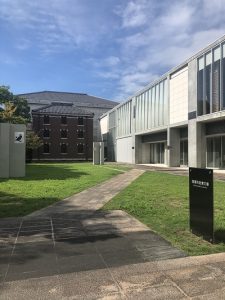
当初、図書は奥の煉瓦造りの建屋が書庫でありましたが、現在は写真の右側の新しい図書館兼博物館こ所蔵保管しているようです。こちらの旧書庫は大正時代の建物でありまして大震災や空爆にも耐え、現在は国の有形文化財に登録されております。
地上3階、地下1階建の旧書庫は、内部の書架のさまざまな蔵書の大きさや形態にあわせ、幅や奥行き、棚の高さを変えたオーダーメイド品で、湿気がこもらないように書架は板を貼らず、床もすのこ状になっているようです。また、地上3階部分には蔵書、地下1階には新聞・雑誌・岩瀬文庫や岩瀬弥助ゆかりの品々が収められておりまして、どうやら内部が面白そうなのですが、現在は耐震や文化財保護のため見学は一年に一度、にしお本まつりにて内部を特別公開しているようです。
そんな岩瀬文庫に収めれておりました8万冊を超える蔵書は、多岐にわたることが特徴でして、また、これだけの蔵書ですので全国から実物の古書を研究閲覧などで来館される方も多いようです。その本の種類は、歴史、国文学、本草、地誌、絵本、絵巻、地図類など様々。本物の蔵書の閲覧には予約が必要のようですが、一部を本物と同じような状態に複製された古書が展示しており、それらのレプリカは我々でも手に取ることができます。
もちろん我々は唐突の訪問ですので(実物などは恐れ多い…。)レプリカの一部を手に取ってみました。
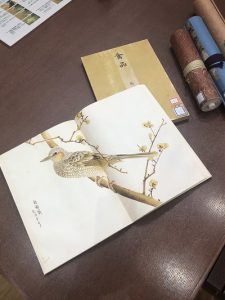
こちらは、「禽品」と呼ばれるいわば、鳥類の図譜。図鑑と言ったところでしょうか。図は精密な濃淡彩色入りでして、一部に産地等の簡略な注記などが。
奥書等はなし。元の編集者は山本渓山(章夫)でありまして、当時は印刷などありませんから、それらを書写した本であります。よって、「渓山写生」「渓山真写」「嘉永己酉(2年)季冬渓山写」等の書写識語あります。書中最新の年記は巻5の「鸊鷉卵」の「明治廿六年七月鳥飼村上田辰二郎持参」と記載されており、嘉永初年より漸次書き継がれたもののようです。
書写本(こちらはレプリカ)ではありますが、書写の域をこえておりまして、しばらくその美しい鳥の羽一本一本の描写や構図に見とれておりまして、この古書の復刻版は出ないのかと本気で思ったくらい美しく手に取ってみたくなる古書でした。
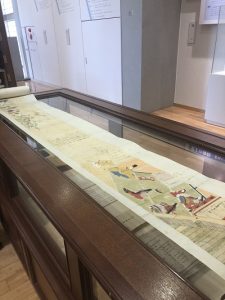
また、蒔絵のレプリカも手に取ることができまして、残念ながらタイトルもわからず、中に書いてる文字も読解できず、絵の内容からですと、どうやらお坊さんと恋仲になった姫君が妖怪?化け物?になるという怪談話なのか、途中で、か弱い姫君が化け物の形相になるという。その形相が現代のアニメや漫画とは違った真の怖さに迫っており、怖い。怪談物は時代を超えてファンがいたのでしょうね。
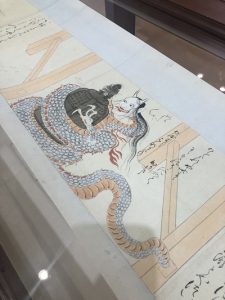
ふらりと立ち寄った岩瀬文庫でしたが、思いのほか興味深く、そしてそれらの研究をされている方にとっては資料の宝庫のようなところでありました。西尾市を訪れることのがございましたら、抹茶パフェと同時にお立ち寄りくださいませ。
それでは、当初の旅の目的でした、あの深い緑の沼へハマって参ります…。
抹茶パフェ、いただきまーす。
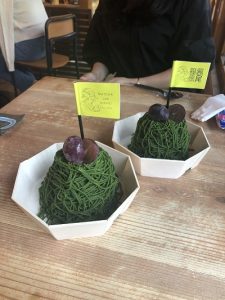
As I have been saying in my blog for a while, my hobby is sudden outings and drives. And even the motive is always sudden.
The other day, for some reason, I was really missing the green color of green powdered tea. I had a sudden desire to eat that deep green food. I felt very sorry, but I suddenly asked my friend, “Would you like to go out to eat matcha sweets?” I asked my friend to accompany me on my sudden drive.
Thank you very much for your sudden invitation.
So the other day we went to Nishio City, Nishio City, Aichi Prefecture, which is famous for its matcha (powdered green tea). I am not sure if those of you from other prefectures are aware of this, but Nishio City boasts the largest share of matcha production in Japan.
The city has flourished as a castle town since the Warring States Period, and the townscape, shrines, and temples that have remained since then have made it famous as “Mikawa’s Little Kyoto,” and it is still being reborn as an old and new town today. The town is also famous for its matcha (powdered green tea), and there are many matcha and wagashi (Japanese confectionery) stores in the town, as well as cafes and stores offering wonderful matcha sweets, which has been a big boom for matcha.
I was one of those who were drawn to matcha the other day. The distance from Nagoya City is just right for a short driving course, and I sometimes want to go there.
I decided to stop by at a place I had never visited before, before trying the matcha parfait.
Nishio City Iwase Bunko
The Nishio City Iwase Bunko was founded in 1908 as a private library by Yasuke Iwase, a businessman from Suda-cho, Nishio, who wanted to contribute to society through books. After the war, it became a Nishio City facility and was renovated as Japan’s first “museum of old books” in April 2003, became a registered museum on December 7, 2007, and seems to have celebrated its 100th anniversary on May 6, 2008. Although it looks like a small library, it actually preserves and exhibits more than 80,000 books from a wide range of fields and eras, from classical books including important cultural properties to modern practical books, and offers unique exhibits that allow visitors to learn about the long history and rich culture of Japanese books through hands-on experience. (Admission to the permanent exhibition was free.)
The brick building at the back of the museum was originally used as the book depository, but now it seems to be housed in the new library and museum on the right side of the photo. The old stacks here were built in the Taisho era (1912-1926) and withstood the Great East Japan Earthquake and air raids, and are now registered as a Tangible Cultural Property of Japan.
The stacks are custom-made in width, depth, and shelf height according to the size and shape of the various books in the stacks. The three floors above ground house the library, and the basement floor houses newspapers, magazines, the Iwase bunko, and items related to Yasuke Iwase, making the inside of the building interesting.
The Iwase Bunko’s collection of over 80,000 volumes is characterized by its wide variety of books, and because of this large collection, many people from all over Japan come to the museum to study and browse the actual old books. The books include history, Japanese literature, books on herbs, geography, picture books, picture scrolls, maps, and many others. Although reservations are required to browse the real books in the collection, some of them are reproduced in the same condition as the real ones, and we can also pick up the replicas.
Of course, we visited the museum on a whim (we are too afraid of the real thing…). We picked up some of the replicas.
This is an illustrated book of birds, so to speak. It is a kind of illustrated book. The illustrations are precisely colored in shades of gray, and some of them have simple notes such as the place of origin.
There is no back matter. The original editor was Keizan Yamamoto (Akio), and since there was no such thing as printing at that time, this book is a transcription of the original. Thus, there are some copied words such as “Keizan Shasho,” “Keizan Shinsha,” “Kaei Jiyu (2nd year) Season and Winter Keizan Shasho,” etc. The latest chronology in the book is in vol. 5, which is the first volume of the collection. The most recent chronology in the book is found in Volume 5, “Little grebe egg,” which reads, “Meiji 廿六年7月 Torikai-mura Ueda Tatsujiro dourou,” and it appears that the writing was gradually passed down from year to year from the beginning of the Kaei era.
Although this is a copy (this is a replica), it is more than a copy, and for a while I was gazing at the beautiful depiction and composition of each feather of the bird.
I was also able to pick up a replica of the maki-e, but unfortunately I could not understand the title or the words written inside the maki-e. A ghost story about a princess who falls in love with a monk and turns into a specter or a monster? The story is a ghost story about a princess who falls in love with a monk and becomes a monster or a monster. The form of the monster is different from that of modern anime and manga and approaches true horror, which is scary. Ghost stories must have had fans throughout the ages.
Although it was just a casual stop at the Iwase Bunko, it was unexpectedly interesting, and for those who are studying them, it must be a treasure trove of materials. If you are ever in Nishio City, please stop by and enjoy the matcha parfait at the same time.
Now to my original goal of the trip, the matcha parfait. Bon appétit!
Have a good day.
*********************
ご実家の整理やお片付けなどをされている方のご相談などが多くございます。朝晩少し涼しい季節となってまりましたが、でくれぐれもご無理のないようになさってくださいませ。風光舎では古美術品や骨董品の他にも絵画や宝石、趣味のお品など様々なジャンルのものを買受しております。
お片付けをされていて、こういうものでもいいのかしらと迷われているものでも、どうぞお気軽にご相談下さいませ。
また風光舎は、出張買取も強化しております。ご近所はもちろん、愛知県内、岐阜県、三重県その他の県へも出張いたします。
まずは、お電話お待ちしております。
愛知県名古屋市千種区・骨董 買取
『古美術 風光舎 名古屋店』
TEL052(734)8444
10:00-17:00 OPEN
#西尾市#抹茶#岩瀬文庫#骨董#買取#古書買取

